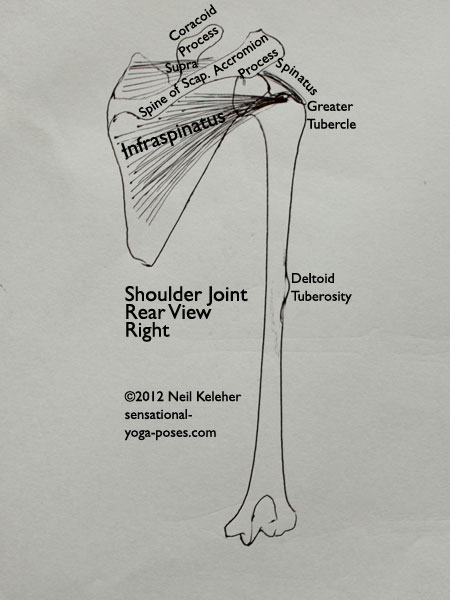Rotator Cuff Anatomy
And other Muscles That Rotate The Shoulder
Because the Rotator cuff muscles are located on the scapulae, any rotator cuff exercise should include awareness and positioning of the shoulder blades.
But in addition, since the shoulder blades can be anchored on the ribcage, these exercises should also include awareness of the spine (including the cervical spine or neck) and ribcage.
Note that some of these exercises are derived from dance of shiva movements.
Muscles that Stabilize (and move) the Scapula
Your shoulder blades "float" on the back of the ribcage.
Muscles that attach the scapulae to the ribcage include:
- serratus anterior,
- rhomboid major and minor,
- trapezius,
- levator scapulae and
- pectoralis minor.
These muscles can be used to move the scapulae relative to the ribcage.
They can also be used to stabilize it relative to the ribcage.
Muscles that Act on the Shoulder Joint
Each scapula is in turn connected to the humerus (the upper arm bone) via the following muscles:
- subscapularis (which is located on the front surface of the shoulder blade, between it and the ribcage)
- supraspinatus (located along the top of each scapulae, above the "spine" of the scapulae.)
- infraspinatus, (located on the back of each scapulae below the spine of the scapulae),
- teres minor, (located just below infraspinatus) and
- teres major (located below teres minor.)
The first four of these muscles constitute the rotator cuff. Their tendons attach high up on the humerus close to the "ball" of the shoulder joint.
The teres major, with its tendon inserting further down the arm bone isn't included in this group even though it shares a similar name.
Other muscles that attach the scapulae to the arm bones include
- the deltoid,
- biceps,
- coracobrachialis
- triceps long head.
Note that both the triceps long head and the biceps both attach to the bones of the forearm (the radius and ulna.)
Of all the muscles that cross the shoulder and attach the scapula to the humerus, the muscles of the rotator cuff are closest to the shoulder joint itself.
Rotator Cuff Individual Muscle Function
The subscapularis attaches to the front of the humerus. When it contracts it rotates the humerus internally (causing the front of the upper arm bone to roll inwards.)
The infraspinatus and teres minor both attach to the back of the upper arm bone. When contracted they rotate the upper arm bone externally.
The supraspinatus attaches to the side of the upper arm bone near the top. When contracted it abducts the arm pulling it out to the side.
When all of these muscles are contracted together so that the work against each other the feeling can be like you are tightening or squeezing the shoulder joint. You could also think of this action as "pulling" the arm into the shoulder socket.
Myofascial Meridians (Anatomy Trains) Relevant to Rotator cuff anatomy
An important consideration when doing Rotator cuff anatomy is the myofascial meridians that run down the front and back of each arm. These meridians link the individual muscles of the arms in four "anatomical trains", two running down the front and two down the back of the arms. Anatomy Trains is a name coined by Thomas Myers to describe the myofascial meridians that link lines of muscle.
The four "anatomy trains" that run down the arm are :
- the deep front arm line,
- superficial front arm line,
- deep back arm line and the
- superficial back arm line.
The deep front arm line runs from the thumb and includes the biceps and pectoralis minor
The superficial front arm line includes the wrist flexors and links to the pectoralis major as well as the latissimus dorsai and possible teres major.
The deep back line attaches from the little finger, and includes the triceps, rotator cuff muscles, levator scapulae and rhomboids.
The superficial back line includes the trapezius, deltoids and forearm flexors.
Other anatomy trains that maybe important are the spiral line (since it contains both the serratus anterior and the rhomboids as well as the spinal erectors) and the lateral line (which includes the sternocleidomastoid, levator scapulae, intercostals and obliques.)
Both of these latter two lines tie the shoulder blades to the torso but also contain muscles that are used in lengthening and stabilizing the torso.
When doing Rotator cuff anatomy it is important to realize that the rotator cuff muscles are part of a system of interlinked muscles and so they may be exercised best when the whole arm (as well as neck, ribcage and spine) is positioned and used with awareness.
This doesnt' have to be as difficult as it may seem.
Published: 2015 07 12
Updated: 2019 11 30



